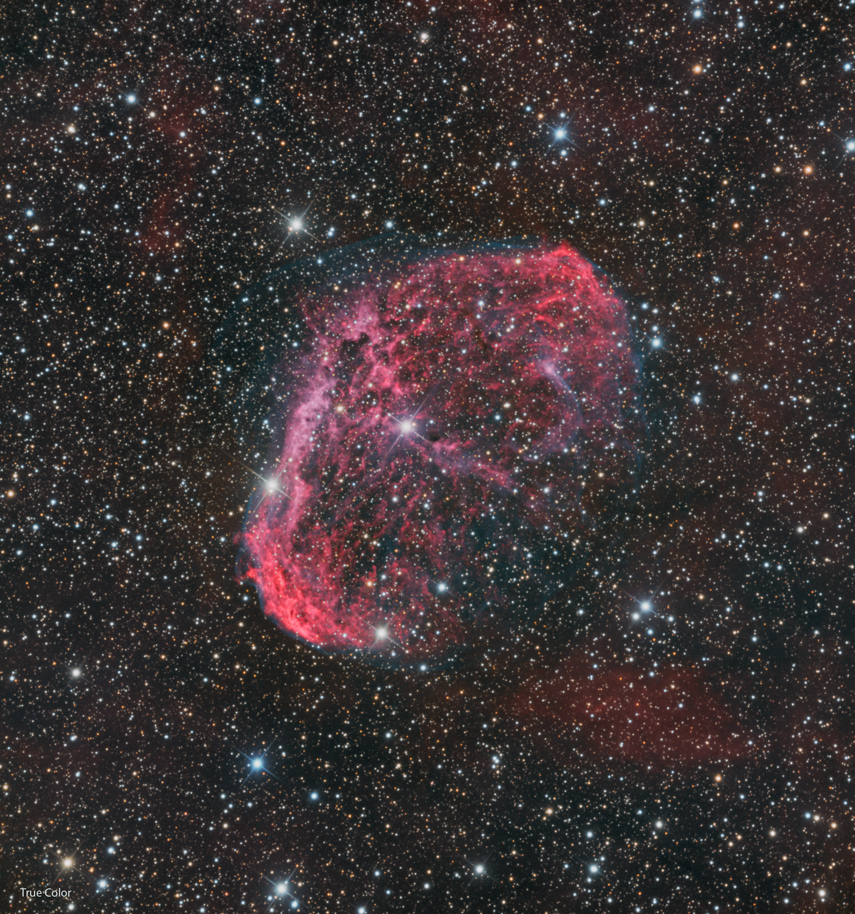HOME
NGC 6888
NGC 6888
Crescent Nebula
Wolf-Rayet Bubble in Cygnus
Click here for higher-resolution versions: 40% (1368x1462) 65%
(2224x2377) 100% (3421x3656)
 Click on image to cycle through the six versions of the image (described below and labeled on the lower left corner of each image)
Click on image to cycle through the six versions of the image (described below and labeled on the lower left corner of each image)
NGC6888: This is a (very dim) nebula formed by the action of the central star (the very bright star at the center of the nebula) expelling its outer gases as it begins
the process of dying. At the first stages of its death throes, the star became a red super-giant, and gently puffed out its outer layers, approximately 250,000 years ago. Then it became
a type of star called a Wolf-Rayet, a rare, short-lived super-hot star, which started expelling gas at a very high rate (an amount of mass equal to our sun's entire mass each 10,000 years),
and at very high speeds, which caused the expelled gas (including the gas expelled earlier, which was hit by the higher speed winds from the Wolf-Rayet phase) to assume something of a shell shape.
It is thought that the central star will become a supernova sometime in the next million years.
The nebula is about 4,700 light years from Earth and is roughly 16 by 25 light years in dimension.
I have presented this in five (yes, 5!) different formats (each image is labeled in the lower left corner); this is the order in which they appear as you cycle through (by repeatedly clicking on the photo,
waiting for each to download):
(i) A bi-color version (almost true-color version; the top photo in the stack), in which "red" is a mix of predominately ionized hydrogen emissions (Ha), with a bit of
singly-ionized sulfur emissions (SII) added, and green and blue are doubly-ionized oxygen emissions (OIII); this works (giving fairly accurate colors) in this nebula because the vast majority of the
emissions are in Ha or OIII, and Ha is in the red part of the spectrum, while OIII is blue-green;
(ii) A true-color version, with the color created by imaging through red, green and blue filters (with a significant amount of Ha and OIII data blended in to all channels, in
varying percentages);
(iii) A true-color version, with the color created by imaging through red, green and blue filters (with no narrow band data included);
(iv) A version in the Hubble palette (a lot of the Hubble photos, including and especially the famous "Pillars of Creation," are made with this set of filters, since
it's a useful set for scientists to see what's actually happening), which shows SII emissions as red, Ha emissions as green, and OIII as blue;
(v) A pure Ha version (grayscale, showing only light in the very narrow Ha band), and
(vi) A pure OIII version (grayscale, showing only light in the very narrow OIII band).
The "true color" version is meant just to show approximately the colors of the object (two version are to show the benefits of weaving narrow-band data into the image); the "almost true-color"
version is pretty, and shows the dominant emissions (Ha as red and OIII as blue-green)
quite graphically in one frame; the Hubble palette is just because Hubble does it that way, and it's interesting to add the (relatively sparse) sulfure emissions; and the two grayscale images
just because they're so pretty (and it is interesting to see how different they are).
This is the second time I have imaged this target; the first time was when I was just starting with this hobby, with fairly elemental equipment (at least by comparison), and from my own yard. If you
want to see if there has been any improvement, click here.
Technical Information:
Ha:OIII:SII:L:R:G:B: 540:600:420:885:280:240:415 (a total of over 56 hours of light-frame exposure time); luminance exposures were a mix of 5-minute and 15-minute exposures;
Red a mix of 5-minute and 15-minute exposures; green were all 15-minute exposures; blue a mix of 15-minute and 20-minute exposures; Ha, SII and OIII were all 30-minute exposures.
Equipment: RC Optical Systems 14.5 inch Ritchey-Chretien carbon fiber truss telescope, with ion-milled optics and RCOS field flattener, at about f/9, and an SBIG STX-16803 camera with
internal filter wheel (SBIG filter set), guided by an SBIG AO-X, all riding on a Bisque Paramount ME German Equatorial Mount.
Image Acquisition/Camera Control: Maxim DL, controlled with ACP Expert/Scheduler, working in concert with TheSky X.
Processing: All images calibrated (darks, bias and sky flats), aligned, combined and cropped in Pixinsight. Color combine in Pixinsight. Some finish work (background neutralization,
color calibration, deconvolution, lessening the dynamic range and noise reduction) done in Pixinsight; some cleanup finish work was done in Photoshop CC.
Location: Data acquired remotely from Deep Sky West Remote Observatory, Rowe, New Mexico, USA.
Date: Images taken on many nights in July, August and September 2019. Image posted September 30, 2019.
Date: Image scale of full-resolution image: 0.56 arcseconds per pixel.
CCD Chip temperature: -25C
Copyright 2019 Mark de Regt
